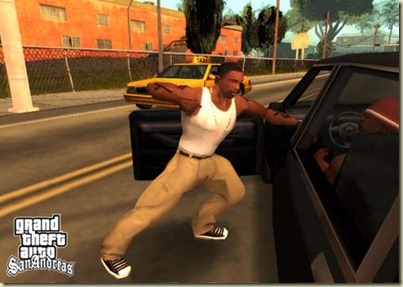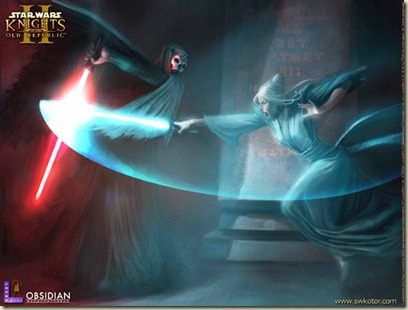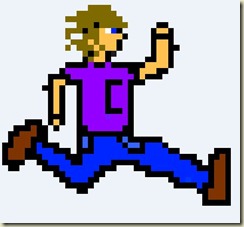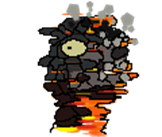 The Senator also held that the bill was ultimately intended to assist parents in determining what content their children can access and that parents can choose to opt out of the policy by purchasing violent games for children, thus, pre-informing parents about content. Thus, the bill would reinforce the measures that the industry already takes in order to police its own content. Built-in parental controls by console manufacturers, the ESRB, ID check at retail and the refusal of console companies to license AO rated games are such measures. By governmentally reinforcing the industry's standards, notable risks arise given the degree of power the state gains over it. This ultimately makes the bill redundant to the industry's already held policies, rendering it a rather unnecessary exercise of political power over content advisory and the medium itself.
The Senator also held that the bill was ultimately intended to assist parents in determining what content their children can access and that parents can choose to opt out of the policy by purchasing violent games for children, thus, pre-informing parents about content. Thus, the bill would reinforce the measures that the industry already takes in order to police its own content. Built-in parental controls by console manufacturers, the ESRB, ID check at retail and the refusal of console companies to license AO rated games are such measures. By governmentally reinforcing the industry's standards, notable risks arise given the degree of power the state gains over it. This ultimately makes the bill redundant to the industry's already held policies, rendering it a rather unnecessary exercise of political power over content advisory and the medium itself. Sunday, December 26, 2010
Discussing the EMA Case with Senator Leland Yee
 The Senator also held that the bill was ultimately intended to assist parents in determining what content their children can access and that parents can choose to opt out of the policy by purchasing violent games for children, thus, pre-informing parents about content. Thus, the bill would reinforce the measures that the industry already takes in order to police its own content. Built-in parental controls by console manufacturers, the ESRB, ID check at retail and the refusal of console companies to license AO rated games are such measures. By governmentally reinforcing the industry's standards, notable risks arise given the degree of power the state gains over it. This ultimately makes the bill redundant to the industry's already held policies, rendering it a rather unnecessary exercise of political power over content advisory and the medium itself.
The Senator also held that the bill was ultimately intended to assist parents in determining what content their children can access and that parents can choose to opt out of the policy by purchasing violent games for children, thus, pre-informing parents about content. Thus, the bill would reinforce the measures that the industry already takes in order to police its own content. Built-in parental controls by console manufacturers, the ESRB, ID check at retail and the refusal of console companies to license AO rated games are such measures. By governmentally reinforcing the industry's standards, notable risks arise given the degree of power the state gains over it. This ultimately makes the bill redundant to the industry's already held policies, rendering it a rather unnecessary exercise of political power over content advisory and the medium itself. Saturday, December 25, 2010
Explorations in Gaming: Year in Review
Wednesday, December 22, 2010
Goldeneye 007 (2010) Review
Reverent Tribute or Blasphemous Desecration? Single-Player
For one, much like the original, this is a stealth/shooter hybrid. Running and gunning leads to many deaths, and thus, enemy placement is designed to promote a stealthy play-style. Enemies are positioned so that tactical planning of attacks is necessary. A stealth-takedown move is preformed by maneuvering behind an enemy and following a motion prompt, allowing for the player to eliminate enemies unnoticed. This stealthy method of play is extremely satisfying and gives what could have been an overly generic shooter its own unique play style. While the N64 game was geared towards run-n-gun gameplay, it still was filed with stealth-sequences. Fans of the original will be pleased to see this style of play replicated in 2010.

Unlike the original Goldeneye’s short, snappy levels, Goldeneye for the Wii has a very lengthy campaign with some incredible set pieces. While the N64 versions levels could be completed in five minutes, the average Goldeneye Wii level takes about 25 minutes to complete, resulting in one of the meatiest single-player games in recent memory. Goldeneye’s weapon set also mixes Call of Duty and the N64 games dynamics to an excellent effect. Weapons feel powerful, sound great and are excellently modeled. Pulling off headshots with a high-powered Pavlov sniper is as fun as it was years ago, and while it might not have the spectacle that other recent AAA shooters are known for (read: Reach, Black Ops), Goldeneye’s campaign stands alone both as a modernization of the original and a new experience. Level layouts may be entirely different, but they differ to Goldeneye’s benefit
.
Nonetheless, one innovation that this game utilizes that has been sorely underused in modern FPS games are multiple objectives. As the player increases the difficulty, new objectives must be completed, thereby changing the experience and adding a replay value rare in modern shooters (no pun intended). The original Goldeneye had this scaling difficulty system and not since the TimeSplitters series has this been used. Needless to say, the utilization of this difficulty system makes this modern game so much more honest to the original, and thus, so much more fun.
Ultimately, Goldeneye 2010 does indeed succeed in replicating the original games aesthetic despite its newer mechanics and is a worthy successor to the esteemed 007 title.Whether or not it can create as many fond memories as the original remains debatable.
Graphics, Control and Sound
Goldeneye 2010 is by no means a good looking game compared to game like Corruption or Red Steel 2, and despite the best intentions of the art team, Goldeneye’s artistic direction feels generic in the face of the recent surge of modern-warfare inspired shooters. The game runs off developer Eurocom’s Dead Space Extraction engine, and thus, features some very impressive facial animation and lighting effects. Light sources are awash with ample bloom-lighting and reflect and bounce off beautifully off polished surfaces. Mo-capped and facially scanned character models are impressive in detail and react realistically.
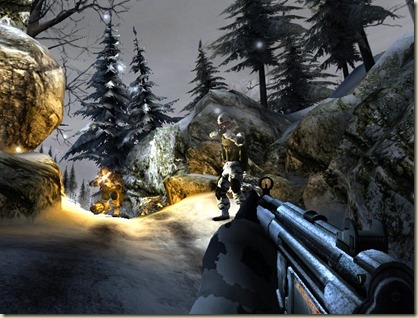
Nonetheless, the graphics do fall short in certain areas. For one, some textures are rather blurry compared to other Wii games. Bullet-holes leave a noticeable decal and the frame rate drops slightly at busy times. Goldeneye’s engine might lack the sophistication of The Conduit’s Quantum3 engine and it might also lack the inspired artistry of Corruption, nonetheless, the framerate is solid almost all of the time and rarely drops and the texturing won’t get in the way of enjoyment.
Goldeneye’s controls, much like its graphics, pale in comparison to titles like The Conduit and Corruption. The pointer-based controls are excellent, without many problems. Nonetheless, I often wished for a quick-turn button which would allow for me to snap back to engage with threats behind me, as the default turning speed was too slow for my taste. Nonetheless, Goldeneye features extremely customizable controls through which every button can be remapped and the bounding sensitivity can be adjusted. In addition, the game also supports Zapper, Classic Controller and Gamecube support. Gamecube control, while functional, is not recommended as the C-Stick is too small and stubby to work well for long play sessions. Ultimately, the bundled Classic Controller Pro works best for this game, with button mapping being flawless.
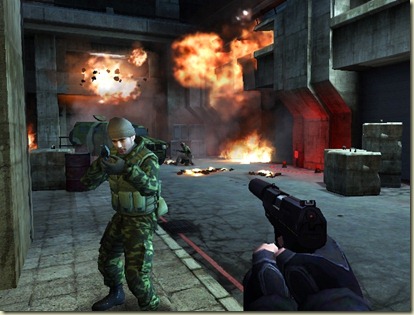
Sound-wise, the game is excellent. Daniel Craig leads the voice-cast of the game as Bond providing a very authentic recreation of the events of Goldeneye. Music, while repetitive, remains reminiscent to that of the series and sets up the game’s tone and mood very well.
Narrative Problems
Nonetheless, a considerable problem facing Goldeneye is its story.While thematically, it is refreshing to have a fun espionage-themed shooter in face of the gritty war titles we have received in recent years, Eurocom’s attempt at modernizing the Goldeneye story falls absolutely flat in seven instances, leaving gaping plot holes.
Spoilers!
For one, by moving the events of the game to occur in 2010, the writers have essentially made Treylevan’s motives for attacking the Bank of England useless, his motives seemingly become hazy. Also, the dam mission, now coinciding with the rest of the story, makes the relationship between Janus and Ouromov confusing and unclear. If Treylevan was working for the Russians under the guise of a MI6 member, how did he survive the gunshot wound and why did he kill so many Russian operatives. Goldeneye’s story is minorly tainted in this revival and is one of the weaker parts of this game.
Multiplayer
Goldeneye 64 was known for its innovative split-screen multiplayer mode, which attracted a cult-following in the late 90s in college dorms and high-school basements everywhere. Surprisingly, the revival’s multiplayer is very robust for the Wii, while it may not necessarily cut into the TF2 time, the online multiplayer is both fun, responsive and addictive. While not as deep as the recent Call of Duty: Black Ops, one can appreciate the smaller maps and reduced player-count, leading to better balance, simpler gameplay and fewer infuriating spawn-kills and deathstreaks.
Structurally, Goldeneye is considerably simplified Call of Duty. Character customization is limited to three perks, a primary weapon, secondary weapon and a primary weapon attachment. Thus, success depends on reflexes and marksmanship rather than map memorization and camping. The low-player count reduces the risk of frustrating spawn kills and the lack of killstreak awards keeps things simple and controlled. The same simplicity is one of Goldeneye’s faults, and while it is fun to pop online for a few quick matches, online multiplayer eventually grows repetitive and the lack of voice-chat significantly reduces the appeal. Online Multiplayer fanatics might rather look at Black Ops or the upcoming Conduit 2.
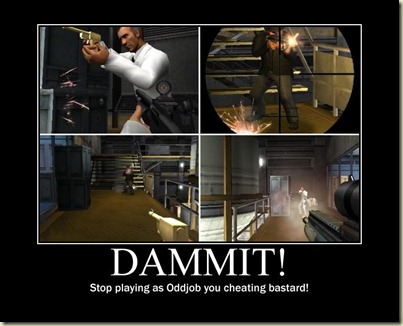
Thankfully, true to the original, Goldeneye 007 features not only some of the best local multiplayer shooting on the console, but of the entire generation. While modern shooters have focused more on online play, seldom is excellent local multiplayer a focus for developers. Sure, there is Call of Duty, but one does get tired of playing Rust and Nuketown for the umpteenth time. Goldeneye 007 does an excellent job of fine-tuning its maps for raucous split-screen matches. While the fact that the pre-set loadouts does limit strategic depth, the sheer accessibility of the experience is reminiscent to the quality of the original N64 game. A bevy of character models and the large variety of control options allows the game to access a wide audience. The masterful degree of customization allows for a degree of rule-changing depth unseen since TimeSplitters 2. Needless to say, Goldeneye 007 offers a refreshing change of pace, and while the online multiplayer might not be as robust as other FPS games, the split-screen will give ample reason to leave the disc in your Wii for weeks at a time. Highly Recommended. 4.5/5
Friday, December 17, 2010
The Psychological Ramifications of the EMA Case
The law states that violent video games are ones in which the range of options available to a player includes killing, maiming, dismembering, or sexually assaulting an image of a human being in a manner that's "patently offensive," appeals to a person's "deviant or morbid interests," and lacks "serious literary, artistic, political, or scientific value." ~ Gregory Leporati
On November 2nd, 2010, the US Supreme Court heard a case named Schwarzenegger v. Entertainment Merchants Association. The case regarded a challenge to California’s currently held violent video game laws, respectively AB 1792 and 1793. Which were created by State Senator Leland Yee after the controversy regarding the Hot Coffee mod to Rockstar’s Grand Theft Auto: San Andreas, a fan-created hack that allowed the player to have sex with a female avatar. Under the challenged laws, any video game that would allow for violent acts to be preformed onto a human character would be cordoned off in a separate section of a store, require ID to purchase and bear a two-inch sticker warning of dangerous content, essentially placing video-games on the level of guns, pornography and alcohol. During the case itself, Justices Scalia, Sotomayor, Roberts, Kennedy and Ginsberg expressed skepticism towards Zack Morazzini, who represented California’s objections towards violent games. The Justices agreed that the laws posed a serious infringement on the First Amendment rights of game developers and that exceptions should not be made for content accessible by both children and adults, Kennedy stated that “You are asking us to create a -- a whole new prohibition which the American people never -- never ratified when they ratified the First Amendment." Nonetheless, Justice Breyer pressed the EMA representative on the psychological effects of violent games on children, questioning the notion that a First Amendment exception should be made for a different medium. Running With Scissor’s Postal 2 was brought up for discussion, a poorly selling sadistic action game which allowed for the maiming and abuse of children. The EMA took the position that “there is not a violence exception to the First Amendment for minors and there should not be". Ultimately, the courts were skeptical of the California video-game laws, believing them to be a First-Amendment violation, nonetheless, the psychological effects of gaming left the members ambivalent, as neither side had any solid evidence pointing to whether or not video games were indeed harmful to minors.
I chose to cover this article because it involves me personally as both an avid video-game player and an indie game developer. Writing an open-letter to Leland Yee (http://bit.ly/cOfE6T) a few weeks ago, I protested against California’s attempt at regulating an artistic community that I am very much part of. There is a considerable lack of solid evidence pointing at a causal relationship between video-game violence and real-world violence, leaving the relationship entirely speculative. In fact, surveys indicate that youth violence has decreased significantly in the past fifty years, while this may not be a causal relationship it is clear that video game consumption has rose in the last fifty years. While there is undeniable that media of any kind has an effect on its audience, and that young children are especially easily influenced by media, the notion that video games are more harmful than other media, say children’s cartoons or children’s marketing, is extremely shaky. For one, the belief that the play of first-person shooters leads to school shootings is entirely false and a gross oversimplification of social problems facing troubled adolescents, it is proven that a variety of other factors, such as parental and peer relationships (or lack thereof) are the causal factors of violent behavior in children, not game consumption. In addition, if a causal relationship were to exist, the rampant popularity of the Halo and Call of Duty franchises would have lead to the total annihilation of society, as no such thing happened, the causal relationship cannot exist. Furthermore, should the Supreme Court side with California and treat video games like pornography, guns and tobacco, games will essentially become a taboo hobby, their consumption being frowned upon socially. Having played games since three and recently helped in the foundation of an indie studio, I cannot allow this to a happen. I have recently received an email back from Senator Yee’s office, expressing interest in a meeting to discuss the matter and the ramifications that the case entails.
Leland Yee, the California State Senator who originally created AB 1792 and 1793, is a child psychologist. A considerable portion of the organizations filing amicus briefs in support of California cite the possible adverse effects violent games might have on children, the rest believing violent games to be mere obscenity. However, the professional psychological community is entirely split on the subject. Dave Grossman, a West Point psychology professor, holds that game publishers are essentially training children to use weapons and are systematically desensitizing them to violence, calling first-person shooter games “murder simulators”. On the other hand, child psychologist Lawrence Kutner wrote in his book Grand Theft Childhood that his studies indicated that children who did not play video games were statistically more likely to participate in violent behavior. A Texas A&M study published just this year concluded that there was no link between violent game consumption and school shootings. Nonetheless, another Iowa State University article linked video-game play to increased levels of aggressive behavior and thought. The lack of consensus within the psychological community leaves the veracity of the notion that game violence causes real violence questionable, and thus, requires further research and understanding to reach a compromise, if one is needed, between game developers and concerned parental organizations. Ultimately, if there is indeed an explicit link, the question will come down to whether or not such behavioral affects would justify First Amendment exceptions.
Sunday, December 5, 2010
Sunday Sites 68
Saturday, December 4, 2010
Platformertown Developer’s Diary (Part 1)
Hey readers,
For those of you who don’t already know, I participated in the foundation of a new indie game development studio along with some of the alumni of COSMOS UCSC Cluster 5 2010. Our first game is tentatively titled Platformertown, a 2D Java based platformer, on which I am art director. Our project wiki can be found here. Right now, here are some preliminary sprites and art assets to be found within the completed game (we’re going for a “it’s done when it’s done” approach).
 Logo (Credit: Marcus Goldschmidt)
Logo (Credit: Marcus Goldschmidt)
Main Player Character (running)
Main Player Character (Jumping)
Signpost Enemy
Waterball
MagmaMonster Boss
Well, that’s it for now. Come back later for more developer’s diaries as well as an upcoming review of the new Goldeneye.







